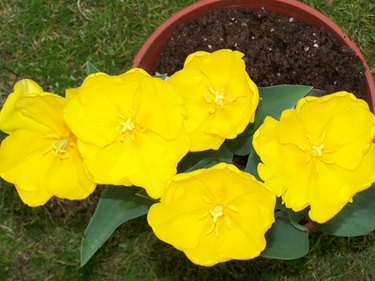Things You'll Need
Roasting pan
Compost
Perlite
Peat moss
Fertilizer

Many of the commercial potting soils do not contain actual soil. Soil-less mixes often are considered superior because they are weed- and disease-free as well as being lighter and better draining. Several different mediums are combined to create the potting soils. Perlite is one of these mediums. Perlite is a volcanic glass that expands when heated and resembles small pieces of packing foam. It aids drainage in soil-less and soil-potting mixes. Creating your own perlite potting soil is less expensive than many of the purchased mixes on the market.
Step 1
Sterilize the compost or garden loam to kill any weed seeds or disease organisms before making the perlite mix. Moisten the compost and spread it out in a disposable roasting pan. Bake at 250 degrees F for 30 minutes.
Video of the Day
Step 2
Mix 1 part compost with 1 part perlite and 1 part peat moss.
Step 3
Mix 2 tbsp. of a balanced fertilizer, such as 20-20-20 analysis, with each bushel of perlite mix to add the rest of the nutrients necessary to plant growth. The mix will require additional fertilization with soluble fertilizer starting 10 weeks after planting.
Tip
Compost adds nutrients to the mix, perlite aids drainage and peat moss helps retain the proper moisture level in the mix. Perlite is sold by the bag at nurseries and garden centers. Sand can be substituted for perlite if absolutely necessary, though it does not provide drainage as well and is more likely to compact in the pot.
Warning
Do not heat perlite in the oven to sterilize it. Perlite has already been heated by the manufacturer. Further heating can cause the perlite to produce noxious gases. Store unused perlite and perlite potting soil in a sealed bag or plastic tub so that it remains sterile until you are ready to use it.
Video of the Day